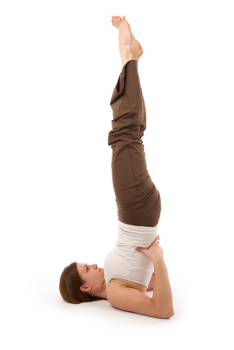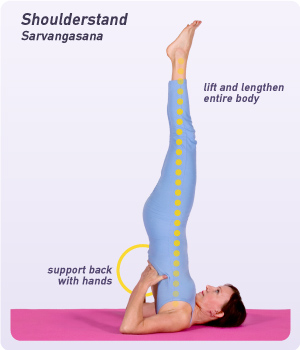How to Do Supported Shoulderstand in Yoga

Supported Shoulderstand is an inverted yoga pose that stretches the back of the neck while strengthening the spine and core muscles. It is appropriate for intermediate to advanced yoga students. Shoulderstand is such an important pose with so many benefits that it is referred to in many yoga traditions as the "Queen" or "Mother" of all yoga postures ("asanas" in Sanskrit). The "King" or "Father" of all asanas is Headstand, which is often performed in conjunction with Shoulderstand.
The Sanskrit name for this pose, "Salamba Sarvangasana" (sah-LOM-bah shar-vahn-GAHS-uh-nuh), comes from five words:
- "Sa" — meaning "with"
- "Alamba" — meaning "support"
- "Sarva" — meaning "all"
- "Anga" — meaning "limb"
- "Asana" — meaning "pose"
The name essentially translates to "All Limbs With Support Pose." The "support" means that your hands are on your back, holding up your torso while your legs are overhead. There are variations of Shoulderstand without hand support. Those are called "Niralamba," which means, "unsupported." However, most yoga classes teach only the supported variation, so this pose is often simply referred to as "Shoulderstand."
Shoulderstand is part of the Ashtanga Yoga closing sequence, and is often done near the end of other yoga classes, along with Plow Pose (Halasana) and Fish Pose (Matsyasana). Shoulderstand relaxes the mind and prepares the body for the final relaxation position, Corpse Pose (Savasana).
Benefits of Supported Shoulderstand
Shoulderstand stretches the neck and shoulders, while toning the legs, buttocks, back, and abdominal muscles. The "Queen of Asanas" provides many other benefits to the entire body, including:
- Stimulated thyroid and prostate glands
- Stimulated abdominal organs
- Improved digestion
- Relief from excess phlegm and mucus
- Reduced fatigue
- Relief from insomnia, asthma, infertility, sinusitis, and the symptoms of menopause
As with all inversions in yoga, the flow of blood to the brain in Shoulderstand helps calm the mind, relieving stress and mild depression. It also helps to improve memory and concentration. This pose will provide a boost of positive energy to your body, mind, and emotions. Regular practice of Shoulderstand can help you feel refreshed and renewed every day!
Within the yoga practices, the postures, the breathing, the living practices - it contains everything that we need.
Cautions
Do not practice this pose if you have glaucoma, diarrhea, headaches, high blood pressure, or if you have recently had a stroke. Also avoid this pose if you have a recent neck injury or chronic neck pain. Women who are menstruating should consult with their teacher before practicing inversions, such as Shoulderstand. Women who are pregnant can practice Shoulderstand if it is already a part of their regular practice; otherwise, wait at least eight weeks after giving birth before attempting this pose.
Do not attempt to learn Shoulderstand on your own. It's best to learn the pose from a qualified and knowledgeable instructor who can provide you with guidance on the alignment before practicing it solo. Always work within your own range of limits and abilities. If you have any medical concerns, talk with your doctor before practicing yoga.
Instructions

- Begin by lying flat on your back with your legs extended and your arms at your sides, palms down. Bend your knees and place the soles of your feet flat on the floor.
- On an inhalation, use your abdominal muscles to lift your legs and hips off the floor. Curl your torso and bring your knees in toward your face. Then, lift your hips and bring your torso perpendicular to the floor.
- Bend your elbows and place your hands on your lower back with your fingertips pointing up toward the ceiling. Keep your elbows on the ground, shoulder-width apart. Do not let your elbows splay out to the sides.
- When you are comfortable, lift your thighs so they are vertical to the floor, keeping your knees bent. Draw your tailbone toward your pubic bone. Then, straighten your legs fully and reach your feet up to the ceiling. Lift through the balls of your feet.
- Try to bring your shoulders, hips, and feet into one line.
- Keep your head and neck in line with your spine and do not turn your head. Draw your shoulder blades firmly into your upper back. Keep a space between your chin and chest, and soften your throat. Gaze toward your chest.
- Hold the pose for 10-25 breaths. More advanced practitioners can hold the pose for five minutes or longer. To release the pose, slowly lower your feet back to the ground, coming into Plow Pose (Halasana) with your hands supporting your back. Then, release your hands to your sides and slowly roll down, one vertebra at a time, bending your knees if you need to. Then, come into Fish Pose (Matsyasana).
Modifications & Variations
Shoulderstand can bring many benefits to your mind, body, and spirit when practiced regularly and with correct alignment. Be sure to make whatever changes you need to reduce discomfort when practicing it. Here are a few suggestions:
- For extra shoulder support, place a folded, firm blanket beneath your shoulders before coming into the pose. Your head and neck should be off the blanket. This extra support can also help prevent neck injury.
- Those with very tight shoulders or large breasts can add more height (2-3 blankets) to feel comfortable and supported.
- In step 4 of the Instructions, only lift both legs at the same time if your abdominal muscles are strong enough. Do not struggle to lift both legs together. If it is too difficult, lift one leg at a time.
- To learn the correct alignment for your upper arms, prepare a yoga strap ahead of time by looping a strap around your upper arms, securing the strap, and then removing it. Come into Plow Pose, slide the strap onto your upper arms (or have a teacher help you), then continue into Shoulderstand.
- Experienced students can experiment with various leg positions, including Bound Angle / Cobbler's Pose (Baddha Konasana), Lotus Pose (Padmasana), or Wide Angle (Upavistha Konasana).
Tips
As with all inversions, Shoulderstand will invigorate and rejuvenate your whole body when practiced correctly! It's crucial to ensure you are performing the pose with correct alignment; otherwise, it's very easy to injure your neck. Be sure to take it slowly and make whatever adjustments you need to reduce discomfort. Keep the following information in mind when practicing this pose:
- Never attempt learning Shoulderstand on your own. Understand the basics of the pose and your body's alignment by learning from a qualified and knowledgeable instructor.
- Lift your chest to your chin, instead of bringing your chin toward your chest.
- Never turn your head in Shoulderstand. Doing so can injure your neck!
- It can be difficult to gauge how vertical your legs are in the pose, so ask your yoga teacher to assess your pose and assist.
- Breathe consciously throughout the pose. Continually bringing your awareness back to your breath will help relax your mind and body even further.
- You might feel awkward getting into the pose for the first time. Take your time and keep your mind on your alignment. Once you're in the pose, you will gain all of the benefits!
- Take the pose slowly — do not swing your legs up.
- Keep your legs active and firm with straight knees. Do not squeeze your buttocks.
- Take your time coming out of the pose. You may feel slightly dizzy if you release the pose and stand up too quickly!
- The counter-pose to Shoulderstand is Fish Pose (Matsyasana). Come into Fish Pose after you have practiced Shoulderstand.
- Be patient. With time and practice, you will gain the strength and poise needed to hold the pose for several minutes.
Invert for the Queen
Supported Shoulderstand can take your yoga practice to a whole new level. Practicing it regularly can be a simple step toward including more intense inversions in your practice, such as Headstand (Sirsasana) and Handstand (Adho Mukha Vrksasana). Shoulderstand will invigorate you after a long day, and can be a soothing, cooling pose at the end of a vigorous yoga practice. Let your mind and breath be calm and steady, and allow "the Queen" to bestow all of her benefits upon you!

